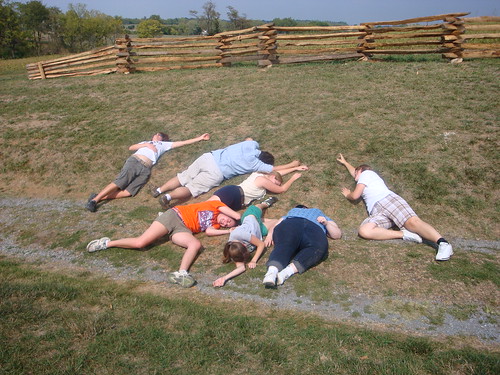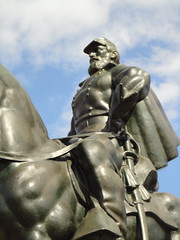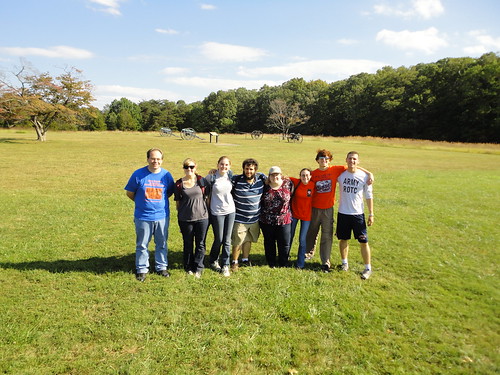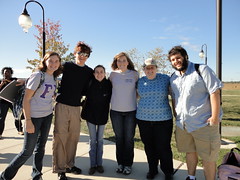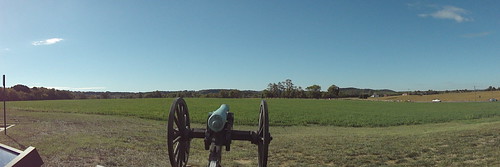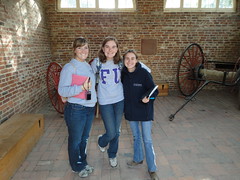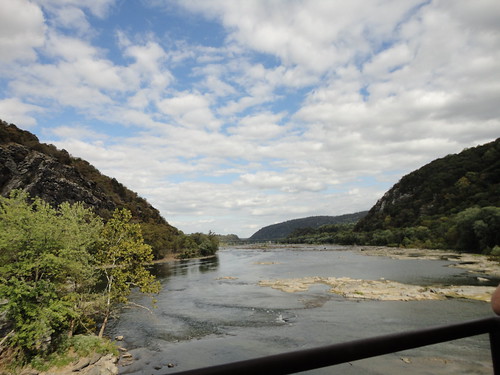The mist hung ominously in the air as we drove cautiously toward the Maryland border. We traveled south once more to tour the Antietam battlefield and learn more about the bloodiest single day in American history.
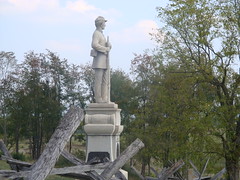 Fortunately, the mist burned off by the time we reached the battlefield where we would spend the day studying the terrain under the tutelage of our guide Dennis Frye. Throughout the day it was interesting to note the dramatic changes in terrain after only a few dozen steps. The reality of these terrain changes helped us more fully comprehend and appreciate the difficulties faced by soldiers on both sides during the battle. Dennis encouraged us to “let the ground speak to us,” to give us a more active role in understanding the battle.
Fortunately, the mist burned off by the time we reached the battlefield where we would spend the day studying the terrain under the tutelage of our guide Dennis Frye. Throughout the day it was interesting to note the dramatic changes in terrain after only a few dozen steps. The reality of these terrain changes helped us more fully comprehend and appreciate the difficulties faced by soldiers on both sides during the battle. Dennis encouraged us to “let the ground speak to us,” to give us a more active role in understanding the battle.
 For me, the most meaningful part of the tour came in the late afternoon as we walked down the Sunken Road, hauntingly referred to as Bloody Lane. Standing at the bottom of the lane forced home the realities of the difficulties faced by Confederate soldiers on September 17, 1862. When positioned in the deepest section of the road, it is impossible to see over one of the embankments, over the other only with great difficulty. The lane would have been a good defense but only as long as the Confederates could hold off advancing troops, after which point it easily became a death trap. Dennis also led us to the section of the road depicted in Alexander Gardner’s famous picture of the Confederate dead awaiting burial. It was a sobering moment as our feet crunched over the rough road where so many men spent their final moments of life.
For me, the most meaningful part of the tour came in the late afternoon as we walked down the Sunken Road, hauntingly referred to as Bloody Lane. Standing at the bottom of the lane forced home the realities of the difficulties faced by Confederate soldiers on September 17, 1862. When positioned in the deepest section of the road, it is impossible to see over one of the embankments, over the other only with great difficulty. The lane would have been a good defense but only as long as the Confederates could hold off advancing troops, after which point it easily became a death trap. Dennis also led us to the section of the road depicted in Alexander Gardner’s famous picture of the Confederate dead awaiting burial. It was a sobering moment as our feet crunched over the rough road where so many men spent their final moments of life.
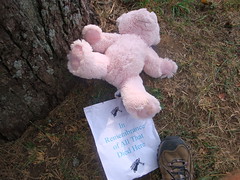 The horror present in Bloody Lane and the rest of the Antietam battlefield still maintains a hold on the American imagination and memory. We saw an example of this hold as we made our way down the Sunken Road. On our right, under the shade of a tree rested a makeshift memorial left by some well-meaning tourist. A stuffed pink teddy bear sat at the base of the tree with a typed note reading “In Remembrance of all that died here.” The homemade memorial reminded us that the Civil War still holds a sacred, almost mythological place in American memory.
The horror present in Bloody Lane and the rest of the Antietam battlefield still maintains a hold on the American imagination and memory. We saw an example of this hold as we made our way down the Sunken Road. On our right, under the shade of a tree rested a makeshift memorial left by some well-meaning tourist. A stuffed pink teddy bear sat at the base of the tree with a typed note reading “In Remembrance of all that died here.” The homemade memorial reminded us that the Civil War still holds a sacred, almost mythological place in American memory.
It was an eye-opening tour that took us to gorily famous areas of the battlefield. The Cornfield (absent of any corn), the Dunker (or Dunkard) Church, Bloody Lane, and Burnside’s Bridge: we saw them all in the course of the day. We marveled at the beauty of the field while trying to wrap our minds around the utter destruction and carnage that had marked Antietam following the battle.
We finished the day with a stop at Nutter’s Ice Cream Parlor in Sharpsburg as we slowly brought ourselves back to the 21st century. The ride home was filled with discussion of the motives behind many of the attacks during the battle of Antietam, and the barely contained excitement for the showers we would take once we arrived back at the Appleford. It had been a hot day, but one that we will surely remember for years to come. Next, we continue our battlefield journey to Fredericksburg and Chancellorsville, Virginia where Lee made some of his most daring maneuvers during the War.
